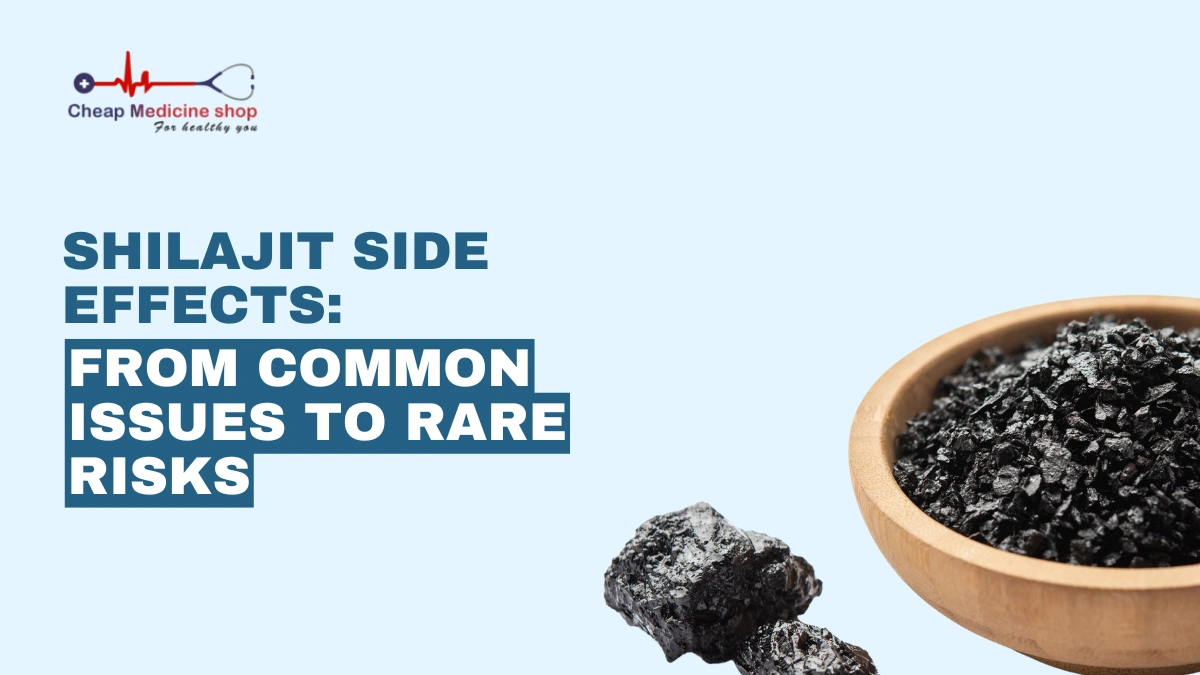If you have been trying out natural supplements for stamina building, chances are you might have come across Shilajit. It is a sticky, tar-like substance primarily found in the Himalayas and has been used as a potent Ayurvedic remedy. Its benefits include boosting energy, improving stamina, supporting brain function, and enhancing testosterone levels.
However, just because it’s natural doesn’t mean it is free from side effects. How your body reacts to Shilajit can depend significantly on your health condition and how you use it. You may sometimes experience dizziness, stomach upset, or even extra strain on the kidneys, especially if you take high doses or already have health concerns.
This article talks about such Shilajit side effects, so you will know what to expect and when to seek medical advice.
What are the side effects of Shilajit?
Shilajit may offer many benefits, but you should also know its possible side effects. These can range from mild ones, like dizziness or an upset stomach, to more serious risks like metal poisoning if you use unpurified products or take too much.
Let’s look into such side effects in detail
Save up to 90% on your medicine bills

Your Happy Shilajit Gummies

Kapiva Shilajit Gold Resin

Leeford Shilajit Tablets

Carmel Organics Ashwagandha Extract Tablets
Most common Shilajit side effects
You might notice some reactions if you’re new to Shilajit or taking more than your body can handle. They can be mild and will typically resolve on their own as your body adjusts to it.
Here are some common side effects of Shilajit that you should be aware of.
- Digestive discomfort: You may feel nausea, vomiting, or stomach cramps. Taking Shilajit with food can make it easier on your stomach.
- Headaches and dizziness: You might feel light-headed or get mild headaches due to fulvic acid, one of its components.
- Allergic reactions: If you’re sensitive to Shilajit, you could develop itching, rashes, or swelling.
- Sleep changes: Shilajit sometimes makes you restless or disturbs your sleep.
- Fatigue instead of energy: Instead of feeling energized, you might feel more tired, especially if you combine it with other supplements or medicines.
- Altered taste: Its mineral-rich composition can leave a metallic or bitter aftertaste that some people might find unpleasant.
Rare but serious Shilajit side effects
Apart from those mild and common side effects, there can be some severe effects that may require medical attention. Here are some rare but serious side effects that you should watch out for.
Pseudohyperaldosteronism
Pseudohyperaldosteronism (soo-doh-hy-per-al-doss-tuh-ron-izm) is a serious health condition that can mimic the symptoms of high blood pressure, low potassium levels (Hypokalemia), and Metabolic Alkalosis, a condition in which your blood becomes too alkaline (high pH). If you experience the following, you should seek immediate medical attention.
- Muscle weakness
- Swelling in your hands or feet
- Fatigue
- Abnormal heart rhythms
Cardiovascular issues
Shilajit may affect your heart and circulation. If you have pre-existing heart conditions or take medication for heart health, this supplement could put extra strain on your cardiovascular system. It can cause:
- Chest pain
- Irregular heartbeat
- Severe drop in blood pressure
Severe allergic reactions
Although uncommon, some people may experience severe allergic reactions to Shilajit. These can include:
- Difficulty breathing
- Facial swelling
- Severe rashes
- Throat constriction
Iron overload
Shilajit naturally contains minerals, including iron. While iron is essential for your body, taking high doses over a long period can sometimes lead to iron overload, especially if you already consume iron supplements or have conditions like Hemochromatosis. Symptoms include:
- Fatigue
- Joint pain
- Abdominal discomfort
Heavy metal poisoning
If you use raw or unpurified Shilajit, particularly the resin form, there’s a risk of heavy metal poisoning. Contaminants like lead, mercury, or arsenic can end up in your body, especially if the product isn’t lab-tested. Heavy metal poisoning can cause:
- Nausea
- Vomiting
- Abdominal pain
- Long-term neurological damage
Hormonal imbalances
Shilajit is often linked with boosting testosterone and supporting hormonal health, but in rare cases, it may actually disrupt your natural hormone balance. You are more prone to experience hormonal imbalances if you have existing endocrine disorders or thyroid problems. This can show up as:
- Mood swings
- Sleep issues
- Libido changes
- Irregular periods
Who shouldn’t take Shilajit
While Shilajit can benefit many people, it’s not right for everyone. Depending on your health condition or medications, taking this herbal supplement could do more harm than good. You should be cautious if you:
- Are pregnant, breastfeeding, or trying to conceive. There isn’t enough research on how Shilajit affects pregnancy or nursing, so it’s best to skip it.
- Have Diabetes, liver disease, or kidney problems. These conditions can affect your blood sugar and how your body processes supplements, making side effects more likely.
- Have an overactive immune system. Conditions like Mast Cell Activation Syndrome (MCAS), Rheumatoid Arthritis (RA), or Lupus may flare up with Shilajit use.
- Have Hemochromatosis. Since Shilajit contains iron, it can raise your levels even more, leading to dangerous complications.
- Have heart disease, blood pressure issues, take blood thinner medicines, or have a clotting/bleeding disorder. Shilajit may interfere with your heart health or affect how your blood clots.
Conclusion
Shilajit is a potent herbal supplement for stamina gain, but it is not side-effect-free. You might notice benefits like better energy, focus, and vitality, but you could also deal with mild side effects such as headaches, dizziness, or an upset stomach. In rare cases, Shilajit may even cause more serious issues like kidney strain, hormonal imbalance, or allergic reactions.
Your body’s reaction to this herbal supplement can vary based on your health, the dosage, and the product’s purity. To stay safe, choose only purified, lab-tested Shilajit and begin with a small dose to see how your body reacts.
If you have existing health issues or experience any unusual symptoms after taking it, don’t overlook them. Consult your doctor to determine if it is suitable for you. That way, you can avoid Shilajit’s side effects and enjoy the benefits.
Frequently Asked Questions
What happens if I take Shilajit daily?
If you start taking Shilajit daily, you may notice benefits like a stamina boost, enhanced cognitive function, and hormonal support. Always make sure that the dosage is appropriate for you and as prescribed by your doctor.
Does Shilajit increase uric acid?
Yes, Shilajit can increase uric acid levels, especially if you take it in higher doses. It may also affect people prone to Gout, an inflammatory type of Arthritis caused by uric acid buildup. Those with already high uric acid levels should be cautious. Always inform your doctor about any health conditions before use.
How long do Shilajit side effects last?
Most mild side effects, like nausea, digestive upset, dizziness, or headaches, usually fade within 1 to 3 days after you stop taking Shilajit. Since it stays active in your body only for a few hours to a few days, the discomfort doesn’t typically last long. However, if the effects stay longer, consult your doctor.
Can I take Shilajit before bed?
Yes, you can take Shilajit before bed. It may help you relax and support better sleep, though some prefer taking it in the morning for an energy boost. For optimal results, take it 30-40 minutes before bedtime.
Cheap Medicine Shop only refers to credible, authoritative sources for our content. If you’re curious about how we ensure the integrity of our content, we encourage you to read our Content Information Policy.














